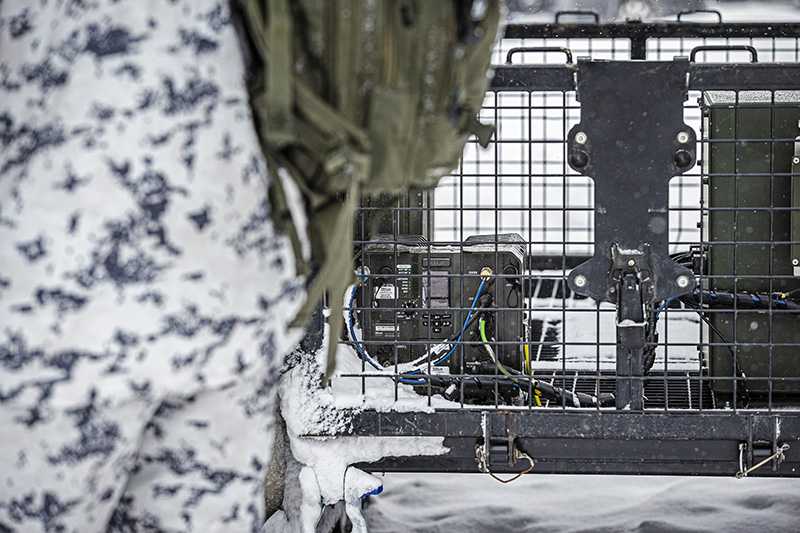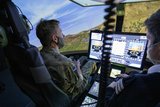What next-generation radios mean for enhanced military operations (Studio)
Brought to you in partnership with Bittium
In recent years, software-defined radios (SDRs) have emerged as the natural successor to CNRs, providing customers with significant technological improvements to maximise operational effectiveness, even in the most complex arenas.
According to Bittium’s Vice President for Defence and Security, Harri Romppainen, while many armed forces still operate legacy CNRs, the transition to SDR technology is inevitable.
‘Armies need new tactical communications capability with wideband waveforms; maximum levels in data throughput; availability of Internet Protocol [IP] networks; and requirement for interoperability with NATO and non-NATO partners,’ Romppainen explained.
As Finland’s national champion in tactical communications, Bittium already supplies SDR technologies to the Finnish Defence Forces (FDF), Estonian (EDF) Defence Forces, and Austrian Armed Forces, for example, which require modern performance in order to enable the required network services and interoperability with European and NATO partners.
In 2017, Bittium signed a Letter of Intent (LoI) with the FDF regarding the purchase of ‘new tactical radios’ to produce and share real-time situation awareness (location, image, voice, video, and sensor data) to all command levels of the organisation.
The LoI made it clear that next-generation tactical radios would be ‘unique in their performance in leading the mobile troops and forming the situation awareness on the battlefield’.
Maximum effectiveness
Bittium’s solutions include the Tough SDR Handheld and Tough SDR Vehicular, both operating in the 30-2500MHz frequency band and offering data throughput up to 26 Mbps.
SDRs allow personnel to send voice and data transmissions simultaneously, providing end-users with maximum situational awareness and C2, streamlining decision-making processes and maximising operational effectiveness.
‘The compact-sized and cost-efficient radios are designed to endure even the harshest conditions, and can be easily installed in different surroundings, providing seamless connectivity from brigade down to company formations using a variety of waveforms,’ Romppainen outlined.

Waveforms currently available for integration onboard Tough SDRs include the broadband Bittium TAC WIN Waveform and ESSOR High Data Rate Waveform, as well as Bittium Narrowband Waveform for robust messaging and voice capability for longer range communications. The waveforms are in continuous development and most recently the FDF ordered additional narrowband waveform development work for the new Tough SDR Vehicular and Handheld radios.
‘The uniquely wide range of frequency bands improves combat usability and enables using the same equipment in different geographical areas. Using several waveforms, even simultaneously with the 2-channel Vehicular radio, improves compatibility and enables operations on different levels and missions,’ Romppainen added.
The deliveries of the Tough SDRs to the FDF have started and preparations are ongoing for the volume field roll-out to replace legacy Tadiran CNRs.
Interoperability tests
Bittium is also employing Tough SDRs to support interoperability tests with the ESSOR High Data Rate Waveform alongside national champions from France (Thales), Germany (Rohde & Schwarz), Italy (Leonardo), Poland (Radmor), and Spain (Indra).
‘ESSOR is being field-tested by the FDF and our offering includes that ESSOR is integrated with the TAC WIN Waveform,’ Romppainen confirmed.
Finland was one of the first ESSOR members to successfully complete national approval tests in the first half of 2021. Previously, ESSOR’s first PTT call was successfully conducted at Bittium’s test facility in Kajaani in 2020, connecting ‘tens’ of nodes from multiple sovereign SDRs, including Leonardo’s S-Wave and Thales’ Flexnet.
Tough SDR Handheld can also be connected to Bittium’s Tough Mobile 2 Tactical LTE smartphone, which can meet the stringent tactical and security requirements of dismounted units in hybrid networks.
Featuring the Bittium Secure Suite, which includes VPN and Mobile Device and Application Management, Tough Mobile 2 can support end-to-end encrypted voice and data communications, in even the most contested of operating environments.
Connected over WiFi, Bluetooth, Ethernet or USB, Tough Mobile 2 displays specialist C2/BMS software, including Systematic’s SitaWare or the Android Tactical Assault Kit (ATAK).
This capability is crucial as it allows platoon and squad members to send messages and observe a common operating picture anywhere on the battlefield and at any time.

Tough Mobile 2 has also been tested and integrated with leading MC-PTT, MC-Video and MC-Data applications, and NATO-certified communication solutions, such as Armour Mobile and Silentel.
The Bittium Tough Vehicular SDR can also be installed with an 4G/5G module which allows the radio to connect to commercial or private networks.
Bittium Tough SDRs can also support multi-domain operations on land and at sea, networked to surface vessels via the TAC WIN wideband waveform.
According to Romppainen, such a capability provides smaller vessels, including rigid hull inflatable and patrol boats, with C4ISTAR capability.
‘Naval forces often operate with HF and VHF solutions that can only support voice and narrowband and non-IP data,’ Romppainen explained.
‘To achieve real-time situation awareness and seamless command chain, the communication system must be able to transmit broadband data from any IP network node to the operations and command centre and back via self-forming and healing networks.
‘These requirements are met with Bittium’s modular, software-defined and interoperable IP-based communications products and systems, including TAC WIN and Tough SDRs.’
More from Studio
-
![Intelligence advantage: How real-time GEOINT is reshaping military decision-making (Studio)]()
Intelligence advantage: How real-time GEOINT is reshaping military decision-making (Studio)
In today’s contested operational environment, adaptability is key. The new Geospatial-Intelligence as a Service (GEO IaaS) solution from Fujitsu and MAIAR empowers militaries by enabling intelligence advantage, combining advanced technology with human expertise to deliver actionable insights.
-
![Training Together: Unlocking Educational Excellence through Military and Industry Collaboration (Studio)]()
Training Together: Unlocking Educational Excellence through Military and Industry Collaboration (Studio)
Military training is ultimately about people. At Capita, training programmes are built on close engagement with partners, delivering an educational approach that can adapt to individual needs, cultivate leadership – and drive wider cultural change.
-
![Enhancing Military Training Through Digital Technology (Studio)]()
Enhancing Military Training Through Digital Technology (Studio)
Digital technologies offer huge opportunities for defence training. However, militaries must adopt an agile approach, placing the needs of their organisations and personnel at the centre of their efforts.
-
![Layered Defence: How new technologies are enhancing armoured vehicle survivability and manoeuvrability (Studio)]()
Layered Defence: How new technologies are enhancing armoured vehicle survivability and manoeuvrability (Studio)
As modern threats evolve, armoured fighting vehicles face a new era of challenges, from loitering munitions to kinetic energy projectiles. Advances in active, passive, and reactive protection systems are crucial to ensuring battlefield dominance, freedom of manouver and vehicle survivability.
-
![Seizing the Future: The Imperative for Militaries to Master AI and Forge Strategic Alliances]()
Seizing the Future: The Imperative for Militaries to Master AI and Forge Strategic Alliances
The current pace of innovation demands a new strategy for success, focusing on developing technology to meet specific defence goals and ensuring collaborative efforts.
-
![Turning the Hiroshima Accord into Action: Enhancing UK-Japan Defence Collaboration (Studio)]()
Turning the Hiroshima Accord into Action: Enhancing UK-Japan Defence Collaboration (Studio)
The UK-Japan strategic partnership leverages joint defence initiatives, advanced technologies, and SME integration to enhance military capabilities, foster innovation, and ensure regional and global stability through collective action and effective project management.
























